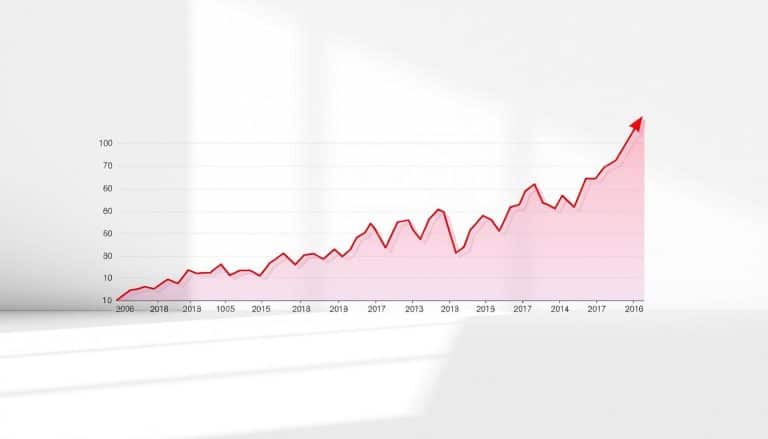Ethereum’s The Verge Upgrade Unlocks Phone Nodes
Did you know that Ethereum’s ‘The Verge’ upgrade might push transaction throughput from 15-30 to over 100,000 per second1? This major leap isn’t only about faster transactions. It tackles big issues like scalability and better energy use in the Ethereum ecosystem. By bringing in phone nodes, Ethereum steps toward easier access for lots of users.
The shift to Proof of Stake means less carbon emissions from mining, kicking off a greener era for blockchain apps1. With Ethereum’s growth, the network will become more decentralized. This opens doors for fresh decentralized apps (dApps) and smart contracts.
Key Takeaways
- Ethereum’s ‘The Verge’ upgrade increases transaction throughput significantly.
- Phone nodes will improve accessibility and participation in the Ethereum network.
- The transition to Proof of Stake reduces energy consumption and carbon footprint.
- Scalability improvements foster the development of new dApps and smart contracts.
- Ethereum aims for enhanced decentralization with innovative blockchain technology.
Overview of Ethereum’s The Verge Upgrade
The Verge upgrade is a big step forward for Ethereum. It brings in new features to make the network better. It uses smart new cryptographic ways to boost how well it works in decentralized finance.
What is The Verge Upgrade?
The Verge upgrade makes Ethereum more scalable and efficient. It aims to increase transactions from 15-30 to over 100,000 per second1. This puts Ethereum ahead in the race of blockchain improvements.
Key Features of The Verge
The Verge introduces Verkle trees. This cuts down on storage needs by nearly 90%1. It also brings proof sizes down to 150-200 bytes for better efficiency1. Plus, switching to Proof of Stake (PoS) means no more energy-heavy mining1.
Importance for the Ethereum Ecosystem
This upgrade tackles big issues like high energy use and network jams. It boosts network performance1. This means lower costs and better economics. It makes Ethereum’s blockchain more green and appealing to developers and users alike.
Introduction to Phone Nodes
Phone nodes represent a new step in blockchain technology. They are simplified versions of traditional nodes, made for mobile use. With phone nodes, more people can join the Ethereum network easily. They don’t need powerful computers to take part. This change is great for the Ethereum world, helping more users get involved and making things simpler.
Definition of Phone Nodes
Phone nodes let users connect to the Ethereum network using their smartphones. They make managing a node much easier, especially for those without much technical know-how. This opens up the network to many more people. As a result, Ethereum becomes more spread out among users, which can boost its value.
Benefits of Utilizing Phone Nodes
Utilizing phone nodes offers several advantages:
- Increased User Engagement: Running nodes on mobile devices draws in more users to Ethereum.
- Simplified Node Operation: Phone nodes make it easier for people to help govern the network.
- Enhanced Accessibility: With lower hardware needs, more folks can join in, leading to a stronger network.
These advancements could greatly benefit the network’s overall health. They might even influence cryptocurrency news positively, possibly hiking up Ethereum prices.
How The Verge Enables Phone Nodes
The Verge upgrade brings big changes, making phone nodes easy and efficient. These improvements are key to letting people take part in decentralized ways using their phones.
Technical Innovations in The Verge
The Ethereum network upgrade brings in Proof of Stake and sharding technology. These make it easier for mobiles to run nodes by needing less power and space. This opens doors for more people to join in using blockchain technology.
Such changes enhance the network’s ability to handle more, while making it safer. This invites more people to take part in decentralized actions online.
Accessibility for Mobile Users
The focus on making it easy for mobile users in The Verge upgrade is a big deal for Ethereum. It lets people use nodes on their phones, bringing in new users. This is a big step towards making blockchain functions available to everyone.
It empowers potential users with tools and interfaces that are easy to use. With better mobile access, Ethereum can draw in everyday folks and serious investors. They can stay connected and active in the network.
Impact on Ethereum’s Decentralization
The Verge upgrade is a big step for Ethereum’s decentralization. It makes running a node easier, letting more people take part. Now, with lower hardware needs, more folks can be validators.
Enhancing Network Participation
Moving to Proof of Stake is key for more participation. With less tech hurdles, more people, especially youths and newcomers, can join. This boosts the community’s variety and strengthens security and governance in Ethereum.
Reducing Barriers to Entry for Users
Making it simpler for new users matches Ethereum’s blockchain goals. With easier entry, more aspiring validators can start participating. This grows the Ethereum community, keeping decentralized finance stable and innovative.
User Experience with Phone Nodes
The user experience with phone nodes has really changed, thanks to Ethereum’s ‘The Verge’ upgrade. It’s now easier for people without a tech background to use these nodes. This means more people can join the blockchain world.
Simplifying Node Operation
Before this upgrade, you needed a lot of tech knowledge to run a node. But ‘The Verge’ upgrade changed that. Now, anyone can do it with just a little know-how. This makes the blockchain more welcoming for all.
User Interface Improvements
There’s been a big boost to how mobile apps look and work too. Everything now feels smoother and easier to use. This lets people dive into Ethereum’s community more easily, encouraging them to get involved.
The Verge’ upgrade by Ethereum has really lifted the mobile node experience to new levels.
The interface is not just easy to use but also packs more features. This helps everyone have a better time managing phone nodes on Ethereum. It’s a key step for making the network decentralized and efficient2.
Security Considerations for Phone Nodes
Integrating phone nodes into Ethereum’s world brings new security challenges. These mobile nodes offer easier access but come with special security risks. They’re different from traditional nodes. Mobile ones can face unauthorized access and data breaches, putting user info at risk.
Risks Associated with Mobile Nodes
Phone nodes often use less secure networks, raising the chance of cyber attacks. Ethereum validators now need to stake 32 ETH. There’s talk of lowering this to 1 ETH, but safety is crucial3. Ethereum is also looking into quantum-resistant options to stay ahead of future dangers, especially from advancements in quantum computing3.
Mitigation Strategies Implemented
To tackle these challenges, Ethereum has put several defense measures in place. They’re using better encryption to safeguard data. Plus, regular security reviews are critical to keep things safe and trusted. The SSLE protocol helps hide who will propose the next block, adding another security layer for mobile nodes3. Teaching the community about security practices is key to keeping the Ethereum network safe. It shows how important it is for users to be alert about blockchain security.
New security solutions like Dual-Layer Staking and Orbit Committees boost both safety and scalability. These methods ensure mobile nodes work well even in tough situations34,). Ethereum’s efforts to fight off 51% attacks show its strong focus on keeping the blockchain secure as it grows.
Comparison with Traditional Nodes
Ethereum’s The Verge upgrade marks a big change in node technology. Unlike traditional Ethereum nodes that need strong hardware and lots of energy, phone nodes work on simple mobile devices. This makes it easier for more people to be part of the Ethereum network.
Scalability Differences
Phone nodes help the Ethereum network handle more work. Thanks to sharding, they spread the work evenly across different parts of the network. Traditional nodes can only manage 15 to 30 transactions per second. But with The Verge, that number could jump to over 100,000 transactions per second. This is a huge step up in making the network bigger1.
Resource Allocation and Management
Phone nodes change how resources are used. They cut down on needed computational resources a lot. This is because of new tech like Verkle trees, which need about 90% less storage than the older Merkle trees. This makes things run smoother and uses less network resources1.
Also, it’s now easier to become a validator node, which opens up blockchain to more people. You don’t need to invest in expensive hardware anymore1.
| Aspect | Traditional Nodes | Phone Nodes |
|---|---|---|
| Hardware Requirements | High requirement, often specialized | Standard mobile devices |
| Energy Consumption | High due to mining | Lower, reduced by Proof of Stake |
| Transaction Throughput | 15-30 transactions per second | Potentially over 100,000 transactions per second |
| Storage Requirements | Significant due to Merkle trees | Reduced by 90% with Verkle trees |
The enhancement of scalability and efficient resource allocation potentially positions Ethereum as a leading entity in blockchain technology.
Ethereum’s new approach with phone nodes is a big leap forward.
Together, phone and traditional nodes make the Ethereum network stronger, bigger, and more efficient1.
The Future of Ethereum with The Verge
With the Verge upgrade, Ethereum is on the brink of big changes. We are looking at faster transactions and better tools for apps. This means more room for creative ideas in Ethereum’s world.
Anticipated Developments Post-Upgrade
After The Verge upgrade, Ethereum’s speed could skyrocket. Imagine going from 15-30 to a whopping 100,000 transactions every second1. This will make the platform easier to use and help spread decentralized finance. Also, Verkle trees will lower storage needs by a lot, about 90%, making everything more efficient1.
Long-Term Vision for Ethereum
Looking ahead, Ethereum aims to be both sustainable and easy to use. It wants to get more people involved and help shape its future. By using sharding, Ethereum can handle more transactions faster1. This builds a strong base for finance apps and puts Ethereum at the forefront of blockchain’s future.
Community Reaction to The Verge Upgrade
The recent Verge upgrade has sparked lots of talk within the Ethereum community. Developers are thrilled with the improvements in speed and efficiency. This could change how blockchain technology is built in the future.
Developer Insights and Feedback
Developers are upbeat about The Verge’s new features. They think these changes will make using Ethereum cheaper and more straightforward. Many expect this upgrade to lead to new and innovative projects. This could help Ethereum grow even more.
Everyone agrees that listening to users is crucial for future changes. This ensures updates meet the community’s needs.
General User Sentiment
Users are really happy with the upgrade. They’re excited about easier access to Ethereum through phone nodes. This could get more people involved and interested.
The talks are focused on how these changes can improve blockchain development. The aim is to attract newcomers to Ethereum. The community plans to use this feedback to make future enhancements better.
Conclusion: The Significance of The Verge Upgrade
The Verge upgrade is a key change for Ethereum, making it faster, easier to use, and greener. With new tech like Verkle trees, it could let us do over 100,000 transactions every second. This jump is huge for how well the blockchain works1. Also, it needs about 90% less storage for blockchain data, which invites more people to join1. Thanks to zero-knowledge proof tech, Ethereum can handle more transactions without getting bogged down or more expensive1.
This upgrade also helps by making it simpler to run validator nodes and needing less powerful machines. This opens doors for more people to get involved with Ethereum. Making it easier for people to join is key for a strong future in blockchain5. What’s next? Ethereum will use these improvements to keep the community strong and stay ahead in the blockchain game3.
Ethereum’s new upgrades pave the way for fresh ideas and teamwork. Projects down the road will keep these upgrades going. This ensures Ethereum grows strong in a tough market. For those backing Ethereum, these changes signal a bright future ahead, full of new chances thanks to this big upgrade.







 Bitcoin
Bitcoin  Ethereum
Ethereum  Tether
Tether  XRP
XRP  USDC
USDC  Wrapped SOL
Wrapped SOL  TRON
TRON  Lido Staked Ether
Lido Staked Ether  Dogecoin
Dogecoin  Figure Heloc
Figure Heloc  Cardano
Cardano  WhiteBIT Coin
WhiteBIT Coin  Bitcoin Cash
Bitcoin Cash  Wrapped stETH
Wrapped stETH  Wrapped Bitcoin
Wrapped Bitcoin  USDS
USDS  Wrapped eETH
Wrapped eETH  Binance Bridged USDT (BNB Smart Chain)
Binance Bridged USDT (BNB Smart Chain)  Chainlink
Chainlink  Monero
Monero  LEO Token
LEO Token  WETH
WETH  Zcash
Zcash  Stellar
Stellar  Coinbase Wrapped BTC
Coinbase Wrapped BTC  Ethena USDe
Ethena USDe  Hyperliquid
Hyperliquid  Litecoin
Litecoin  Sui
Sui  Avalanche
Avalanche  Hedera
Hedera  sUSDS
sUSDS  Shiba Inu
Shiba Inu  Dai
Dai  USDT0
USDT0  Canton
Canton  Toncoin
Toncoin  PayPal USD
PayPal USD  World Liberty Financial
World Liberty Financial  Uniswap
Uniswap  Cronos
Cronos  Ethena Staked USDe
Ethena Staked USDe  Mantle
Mantle  USD1
USD1  Polkadot
Polkadot  Rain
Rain  Bitget Token
Bitget Token  MemeCore
MemeCore